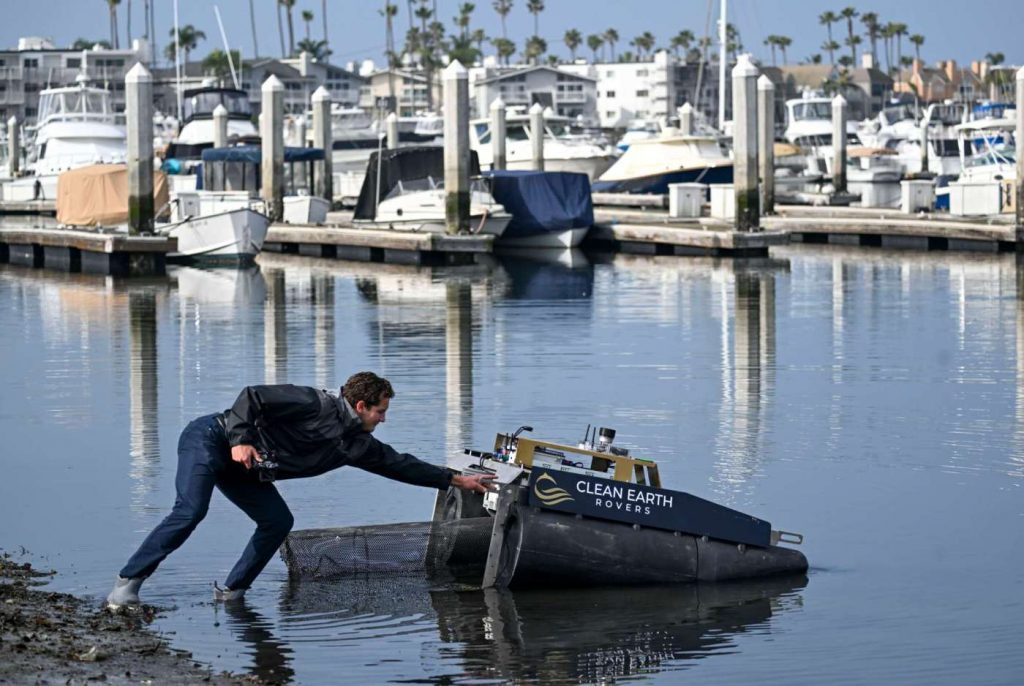Think of it like the Roomba that vacuums floors in a home – but this one cleans up the water.
For the past few weeks, a futuristic-looking contraption has been cruising around, scooping up trash in Huntington Harbour, keeping especially busy as heaps of debris washes down with recent rain storms.
The machine is part of a pilot project by the city of Huntington Beach and Clean Earth Rovers, using a technology created with the purpose of cleaning up harbors, lakes, rivers and oceans.
Clean Earth Rovers co-founder and CEO Michael Arens, who lives in Costa Mesa, created the company with COO David Constantine in 2019 while they were students at Xavier University in Cincinnati, where the company is now headquartered. They have a second office in San Pedro near the Port of Los Angeles.
Already, the rovers have been deployed at six locations in Florida and another in Cincinnati. Huntington Beach’s pilot program is the first in Southern California, though the company is in talks with several other coastal cities to also try out the technology.
Coastal trash is a problem beach towns throughout the state grapple with when storms water flushes debris from streets and elsewhere far inland down drains and waterways, straight into harbors, estuaries and the ocean.
The device being tested in Huntington Beach – named the Rover AV Pro – has been brought out each week at two locations in the harbor, it then works for about an hour for each session.
“We’ve been picking up a lot of different stuff, we’re trying to experiment being there at different times of the day to see when trash is most prevalent,” Arens said.
The machine uses an autonomous software to do sweeping patterns and can collect up to 100 pounds of trash before needing to be emptied.
“Any surface debris that is floating,” Arens said. “The rover can go out on its own, you don’t have to put anyone in the water or launch a vessel or have another person scooping stuff out of the water.”
A bag is towed behind where all the debris is stored and once it completes its mission, it returns to where it was launched, Arens said.
“You can take it out, keep it in the water or send it back out to keep cleaning,” he said.
The rover is 5-by-5-feet in size, making it portable, and has four wheels, so it can be easily launched from a boat ramp or beach and it can be carried on a trailer, Arens said.
Since the trial started on Feb. 1, the rover has brought in about 200 gallons of trash during five cleanups – everything from sticks and twigs to bags, bottles, cigarette butts, balloons and cans of paint. It has filled about six 32-gallon trashcans.
The pilot project ends April 2 and is costing $10,000, according to the city of Huntington Beach.
There has been success with the rover cleaning and removing trash from docks near the mouth of the Bolsa Chica Channel, which is the largest source of trash and debris into the harbor, Jim Merid, environmental services manager, said in an e-mail.
That trash would have eventually sunk to the bottom of the harbor or disintegrated into much smaller pieces and drifted out to the ocean, he noted.
Clean Earth Rovers charges about $300 a full-service visit, which includes delivering a rover, handling the trash after a cleaning, collecting data on what’s been removed and such. Or a machine from the Clean Earth Rovers costs about $30,000 to own and operate.
The technology is one of several innovative ideas being tested out at local waterways to stop the stream of trash that ends up at the coast, not just littering the sand and ocean, but causing harm to species that ingest the junk.
Just a few months ago, Newport Beach broke ground on a large, $5.5 million trash wheel to collect debris in the Upper Newport Harbor.
In Santa Monica Bay, the Ballona Creek Trash Interceptor 007 was deployed as a pilot project in October 2022 and has stopped about 220,000 pounds of trash and debris from entering the Santa Monica Bay and local beaches, according to its website.
The cost of designing and permitting for the Interceptor was about $1.3 million, while construction of the moorings to secure the Interceptor and booms was about another $1.5 million. The Interceptor itself was provided to Los Angeles County for free by The Ocean Cleanup, but there’s a $650,000 price tag for its annual maintenance.
Related Articles
How an episode of ‘The Office’ helped a friend save a surfer’s life
King tides swamp the California coast, gives glimpse at future sea level rise
How computer modeling is helping the Bay Area plan for climate change
California earns an A in Surfrider’s annual State of the Beach report
With climate change, king tides could be the new normal
The rover technology can also be used for oil spills, the company says. It has an absorbent boom attachment that can be towed up to 100 feet behind the machine.
Wildlife, such as fish, birds and other animals, have been moving out of the rover’s path, the same way as when a boat is near, Arens said.
The company is also exploring different community partners to find a better end-life for the trash and is also documenting quantifiable data for policy change such as the type and amount of debris scooped up.
“This is what a lot of people don’t think about: Where does all the trash on the street go? A lot of times it gets washed up into the aqueducts and the channels that lead into the harbors and oceans,” Arens said. “We see not just a severe shift in water quality, but a wave of debris.”


